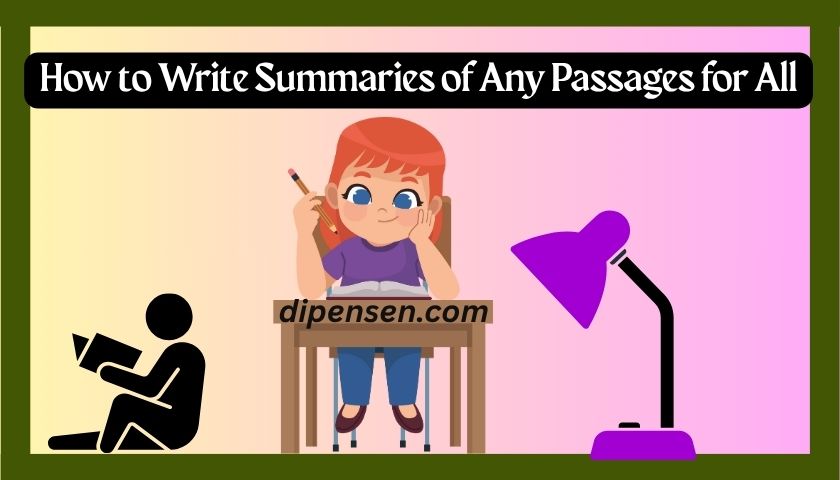How to Write Summaries of Any Passages for All

Summarizing is an essential skill for students, whether you’re tackling literature, history texts, scientific articles, or any other academic material. A well-crafted summary captures the main ideas of a passage in a concise and clear manner, helping you retain information and communicate it effectively.
However, writing summaries can be challenging, especially when you’re worried about copyright issues or struggling to condense complex information.
Why Summarization Matters for Students
Summarization is more than just shortening a text—it’s about understanding and distilling its essence. For students, this skill is critical for several reasons:
- Improves comprehension: Summarizing forces you to identify key points, helping you better understand the material.
- Enhances study efficiency: Summaries make it easier to review notes for exams or assignments.
- Boosts writing skills: Writing concise summaries hones your ability to communicate ideas clearly.
- Avoids plagiarism: By summarizing in your own words, you create original content, steering clear of copyright issues.
Whether you’re summarizing a novel, a research paper, or a textbook chapter, the process remains similar. Let’s break it down into actionable steps.
A summary involves rephrasing another person’s ideas in your own words. Summaries differ based on how much you analyze or interpret the original material, ranging from a few sentences to several pages. Regardless of length, the writer must express the primary points or arguments of the original author in their own words.
Purposes of the Summary
Summaries benefit the reader because they provide a concise and general overview of the original information. For a busy reader, summaries provide quick overviews of material. Summaries also show readers that you have understood the general point of a test, and in this way, teachers can test your knowledge. The process of summarizing someone else’s material enables you to understand that material better.
What and When to Summarize
Many student writers quote when they should summarize material—quote only when the author expresses a point in a particularly telling or interesting language. Otherwise, summarize. Use a summary to restate an entire argument. Use a summary to present information.
How to Summarize
Read the original passage or text very carefully. Pinpoint the key concepts in the original text by highlighting or underlining with a pencil, or record notes in the margins or on a separate sheet. When summarizing a full essay, create an outline of the author’s main arguments.
These notes and outlines should be brief. Using this list of points, you write down the summary, referring to the original text only when you want to make sure of some fact. This will help you to reproduce the substance of the passage in your own words.
Guidelines for Writing Summaries
Summaries can vary in length, from a couple of sentences to multiple pages. What you have to remember is that when you write a summary of something you have read, you make your summary shorter than the original.
A summary is typically about one-third the length of the original text. For example, a 150-word passage would be condensed into a summary of approximately 50 words.
Always use complete sentences to convey the central ideas or information from the text, clearly presenting the author’s key points to the reader.
Don’t quote extensively. If you quote, use quotation marks and document the quotation. If you fail to report the quotation, even one word that the author used, you are plagiarizing material (presenting another person’s information as if it were your own).
Step-by-Step Guide to Writing Summaries
Step 1: Read Actively and Understand the Passage
Before you can summarize, you need to fully grasp the passage’s content. Skimming won’t do—active reading is key. Here’s how to approach it:
- Preview the text: Look at headings, subheadings, or topic sentences to get a sense of the structure.
- Highlight key points: Mark main ideas, arguments, or themes as you read. Avoid highlighting everything—focus on what’s essential.
- Take notes: Jot down the author’s purpose (e.g., to inform, persuade, or entertain) and the main argument or theme.
- Ask questions: What’s the passage about? Who is the intended audience? What’s the core message?
By engaging with the text, you’ll have a solid foundation for summarizing.
Step 2: Identify the Main Ideas
A summary focuses on the big picture, not minor details. To pinpoint the main ideas:
- Look for the thesis or central argument: In non-fiction, this is often stated in the introduction or conclusion. In fiction, it might be the central theme or conflict.
- Find supporting points: Identify 2–3 key points that support the main idea. For example, in a scientific article, these might be the hypothesis, evidence, and conclusion.
- Ignore irrelevant details: Examples, anecdotes, or descriptive passages are often secondary. Focus on what drives the author’s message.
For instance, if summarizing a passage about climate change, you might note the main idea as “Human activities are accelerating global warming,” with supporting points like rising CO2 levels and deforestation.
Step 3: Write in Your Own Words
To avoid copyright issues, always summarize in your own words. Copying phrases or sentences directly from the original text without quotation marks is plagiarism, which can lead to academic penalties or legal issues. Here’s how to ensure originality:
- Paraphrase: Restate the author’s ideas using different words and sentence structures. For example, if the passage says, “Deforestation contributes significantly to carbon emissions,” you might write, “Cutting down forests greatly increases CO2 output.”
- Use simple language: Avoid jargon unless necessary, and explain complex ideas clearly.
- Attribute ideas: If the passage is from a specific source, mention it briefly (e.g., “According to the article…”). This gives credit without reproducing the original text.
By paraphrasing, you create a unique summary that respects copyright laws while demonstrating your understanding.
Step 4: Keep It Concise
A summary should be significantly shorter than the original passage—typically 10–25% of its length. For a 1,000-word article, aim for a 100–250-word summary. To stay concise:
- Stick to essentials: Include only the main ideas and key supporting points.
- Avoid opinions: A summary isn’t a critique. Don’t add your thoughts or analysis unless asked.
- Use clear, direct sentences: For example, instead of writing, “The author goes into great detail about how deforestation is a major issue,” say, “Deforestation is a major environmental issue.”
Trim unnecessary words to make your summary sharp and focused.
Step 5: Organize Your Summary
A well-structured summary is easy to follow. Use this simple format:
- Introduction: State the passage’s main idea or purpose in 1–2 sentences.
- Body: Summarize the key supporting points in a logical order.
- Conclusion (optional): If the passage has a clear takeaway or call to action, mention it briefly.
For example:
In her article on climate change, Dr. Smith argues that human activities are the primary cause of global warming. She highlights rising CO2 emissions from industrial activities and deforestation as key contributors. Additionally, she notes that sustainable practices could mitigate these effects. Dr. Smith emphasizes the urgency of collective action to address environmental challenges.
This structure keeps your summary coherent and professional.
Step 6: Review and Revise
Before finalizing your summary, check for clarity, accuracy, and originality:
- Verify accuracy: Ensure your summary reflects the passage’s main ideas without distortion.
- Check for plagiarism: Use tools like Turnitin or Grammarly if available, but your own words should naturally avoid issues.
- Polish for clarity: Remove vague phrases or overly complex sentences.
- Ensure brevity: If your summary is too long, cut secondary details or tighten wording.
A quick revision ensures your summary is polished and effective.
Common Mistakes to Avoid
Students often make these errors when summarizing:
- Including too many details: A summary isn’t a retelling. Skip minor examples or side points.
- Copying the original text: This risks plagiarism and copyright violations. Always paraphrase.
- Adding personal opinions: Unless instructed, keep your summary objective.
- Missing the main idea: If you’re unsure of the core message, reread the passage carefully.
By avoiding these pitfalls, you’ll produce stronger summaries.
Tips for Practicing Summarization
Like any skill, summarization improves with practice. Try these exercises:
- Summarize short texts first: Start with a paragraph or news article before tackling longer passages.
- Compare with peers: Share your summaries with classmates to get feedback.
- Use diverse sources: Practice summarizing fiction, non-fiction, and academic texts to build versatility.
- Time yourself: Challenge yourself to summarize a passage in 5–10 minutes to improve efficiency.
Regular practice will make summarization second nature.
Ensuring Copyright-Free Summaries
To keep your summaries copyright-free:
- Always paraphrase: Never copy sentences or phrases verbatim unless quoting with proper citation.
- Cite sources when needed: If you’re summarizing for an assignment, mention the source (e.g., author, title) without reproducing the text.
- Use public domain or open-access materials: When practicing, choose texts that are freely available, such as those from Project Gutenberg or Creative Commons-licensed articles.
- Check your school’s guidelines: Some institutions have specific rules for summarizing copyrighted material.
By following these steps, your summaries will be original and compliant with copyright laws.
FAQs
What is the purpose of summarizing a passage?
Summarizing condenses a passage into its main ideas, helping students understand and communicate key points efficiently.
How long should a summary be?
A summary is typically 10–25% of the original passage’s length, depending on the assignment requirements.
How can I avoid plagiarism when summarizing?
Paraphrase the passage in your own words, avoid copying phrases, and cite the source if needed.
What’s the difference between summarizing and paraphrasing?
Summarizing condenses the main ideas of a passage, while paraphrasing restates a specific section in different words without necessarily shortening it.
Can I include my opinions in a summary?
No, unless instructed. Summaries should be objective and focus on the author’s ideas.
Final Words
This guide will walk you through the process of writing effective summaries for any passage, ensuring your work is original and copyright-free. By following these steps, you’ll develop a valuable skill that enhances your academic performance and critical thinking.
To Know more, reading :
👉Completing Story, dialogue, And applications for class Six
👉Composition Writing for Class Six to Eight



